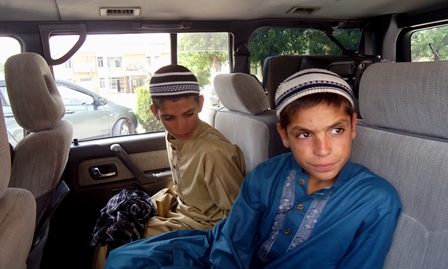Shoaib, Rashid and Ilyas — three children hailing from a Balochistan village stunned by their mysterious illness.
Residents of Mian Kundi, a village some 15 kilometers from Quetta, the children aged one, nine and 13 are forced into stillness when the sun sets and anxiously wait for it to come up again the next day.
At 4 am, they rise with the first rays, filled with energy and life. As the sun travels west, their strength appears to deplete, and they are completely paralyzed by the time it sets.
According to the Pakistan Institute of Medical Sciences (Pims) Chancellor Dr. Javed Akram, theirs is the first reported case of such an illness worldwide. “It is a challenging puzzle for medical science to solve,” Akram says: bodies synced to the sun’s movement.
Hashim, a security guard at IT University Quetta, says his sons were born like this. It wasn’t an anomaly or habit formed later in life; from the first day, he says their bodies appeared dependent on sunlight. So when villagers heard about them, they were amazed and christened ‘solar kids.’
But not all of his kids have earned that title. Hashim, who married his first cousin, has three more children — two girls and a boy — who have escaped the peculiar condition.
He says his town is disease-free, and all basic modern facilities like electricity, phone and gas are available. As a result, people live a healthy, normal life, as in most places in the country. “We are not a backward village,” he clarifies, lest people attribute the roots of the disease back to his hometown.
When one observes them closely, the boys’ daily activities appear normal. The children wake up early, sometimes before sunrise, and are energetic.
After attending classes at a seminary, they play cricket with their friends and spend time with their siblings. They help their father with his part-time livestock farming, tending to the sheep and goats when they can.
“They don’t complain,” Hashim says, “They enjoy doing everything they are told.
The older two are particularly keen on their studies and idolize their teacher, ‘ Maulvi Sahab.’ Shoaib wants to excel in religious studies, and Rashid wants to become a Hafiz-e-Quran.
But despite the ordinariness of their daytime routine, they live with a nagging that their time is limited till late afternoon. As the sunlight fades, the three boys seem to grow lazy. By the time the sun disappears, their energies are drained.
No textbook solutions
Akram claims he has never heard of the condition. “It is a peculiar disease which pushes children into a vegetative state after sunset,” he explains. “We have taken it up as a research project.”
His team works with 27 Pakistanis and 13 international members to solve the case. He hopes to treat the mysterious illness, but first, they must make a successful diagnosis.
Pims has already sent blood samples and test reports to thirteen international collaborators, including Mayo Clinic, John Hopkins Medical Institute in the US and Guys Hospital in London. Hundreds of tests have been carried out but to no avail.
Meanwhile, a team is busy in Mian Kundi village, gathering environmental samples from sand and water.
Hashim is aware of the efforts underway to cure his sons and considers them fortunate. “We’re lucky their illness has not worsened with time,” he notes. However, he adds that the boys are frustrated with their physical limitations. It is a strange thing for a father to watch.
“They know it will happen,” Hashim says, “So they watch the sun’s movements. Their bodies and mind have been trained to complete their tasks in time for bed at sunset.”
Hashim sometimes feels their activity is more ‘time-bound’ than ‘sunlight-bound.’ “In the case of thick clouds or rain, their routine doesn’t change,” Hashim explains. “Often, whether the sun is visible or not, they shut down in the evening.”






